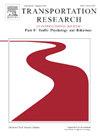Finding windows of opportunity: How drivers adapt to partial automation safeguards over time
IF 3.5
2区 工程技术
Q1 PSYCHOLOGY, APPLIED
Transportation Research Part F-Traffic Psychology and Behaviour
Pub Date : 2025-02-28
DOI:10.1016/j.trf.2025.02.019
引用次数: 0
Abstract
Introduction
Most partially automated systems have safeguards to counteract driver disengagement, but little is known about how they affect driver behavior over time. This naturalistic observation study investigated how the behavior of 14 drivers who had no previous partial automation experience evolved over a month of exposure to the Tesla Autopilot system in a model year 2020 Model 3.
Method
Behavior was analyzed leading up to, during, and immediately after attention reminders and emergency-slowdown-leading-to-lockout events.
Results
We found that drivers learn to internalize safeguard sequences and discover windows of opportunity to do non-driving-related activities. People learned to respond quicker to alerts, leading to fewer escalated sequences in the latter half of the study. However, drivers also spent more time engaging in non-driving-related activities and glancing off-road, which corresponded with more initial alerts of the attention reminder sequence as time went on. Prolonged disengagement culminated in 16 lockouts across the sample, although in general, drivers responded faster and had fewer lockouts over time.
Conclusion
Our findings demonstrate the human ability to learn system constraints and thus illustrate that it is possible to shape safer driving behavior with robust safeguards. User-centric design considerations for driver support strategies are presented.
寻找机会之窗:驾驶员如何随着时间的推移适应部分自动化保障措施
大多数部分自动化系统都有防止驾驶员脱离驾驶的保护措施,但人们对它们如何随着时间的推移影响驾驶员的行为知之甚少。这项自然观察研究调查了14名之前没有部分自动化经验的司机在接触特斯拉2020年model 3自动驾驶系统一个月后的行为变化。方法分析了注意提醒和紧急减速导致锁定事件发生之前、期间和之后的行为。结果驾驶员学会了内化保护程序,并发现了做与驾驶无关的活动的机会窗口。人们学会了对警报做出更快的反应,从而在研究的后半部分减少了升级序列。然而,随着时间的推移,驾驶员也会花更多的时间从事与驾驶无关的活动和扫视越野,这与更多的注意力提醒序列的初始警报相对应。尽管随着时间的推移,司机的反应更快,锁死的次数也更少,但长时间的脱离最终导致了样本中的16次锁死。我们的研究结果证明了人类学习系统约束的能力,从而说明了通过强大的保障措施来塑造更安全的驾驶行为是可能的。提出了以用户为中心的驱动程序支持策略的设计考虑。
本文章由计算机程序翻译,如有差异,请以英文原文为准。
求助全文
约1分钟内获得全文
求助全文
来源期刊
CiteScore
7.60
自引率
14.60%
发文量
239
审稿时长
71 days
期刊介绍:
Transportation Research Part F: Traffic Psychology and Behaviour focuses on the behavioural and psychological aspects of traffic and transport. The aim of the journal is to enhance theory development, improve the quality of empirical studies and to stimulate the application of research findings in practice. TRF provides a focus and a means of communication for the considerable amount of research activities that are now being carried out in this field. The journal provides a forum for transportation researchers, psychologists, ergonomists, engineers and policy-makers with an interest in traffic and transport psychology.

 求助内容:
求助内容: 应助结果提醒方式:
应助结果提醒方式:


